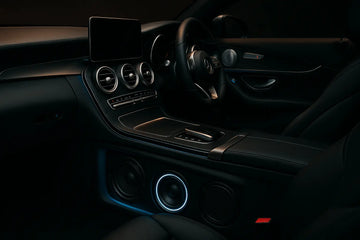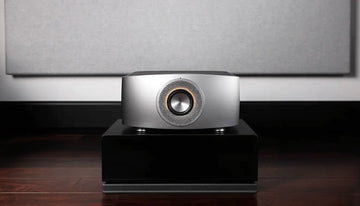5.25 inch Speakers
Related Collections:
Featured Products
Eton PSX13 5.25" Coaxial System
Eton POW13 5" 2-Way Component System
Audio Dynamics ADCX513 5.25" Coaxial Speaker Set
Arc Audio X2 502 5.25" Coaxial Speaker Set
Audio Dynamics 2000 Series 5.25″ Component Set – CS524
Polk DB5252 5.25" Component Speaker System with Marine Certification
Audio Dynamics 2000 Series 5.25″ Coaxial Set – CX524
Ground Zero GZIC 13X 5″ 2-way component speaker system
All products loaded
Explore the Best 5.25 Inch Car Speakers for Superior Sound

Tired of the flat, muddy sound from your factory car stereo? An audio system upgrade is one of the most satisfying improvements you can make to your vehicle, and it doesn't have to be complex or costly. The best place to start is often with the speakers, and for a vast number of cars, 5.25 inch car speakers are the ideal solution. This popular size provides a fantastic balance of performance, versatility, and straightforward installation.
This guide will walk you through everything you need to know about 5.25 speakers. We'll explain why this size is a go-to choice for new audio enthusiasts and seasoned audiophiles alike. From understanding technical specs to choosing between different types and planning the installation, you'll find all the information required to select the perfect speakers for your car, music taste, and budget. Get ready to hear your favorite songs with the clarity and impact they deserve.
Why Choose 5.25 Inch Car Speakers for Your Vehicle?
As you explore the car audio market, you'll find various speaker sizes, from small 4-inch models to large 6x9-inch ovals. So what makes the 5.25-inch size stand out? The answer is its exceptional balance. These speakers are large enough to deliver a full, rich sound yet compact enough to fit into a wide range of vehicles without needing major custom modifications. For many drivers, they represent the "Goldilocks" zone of car audio—they're just right.
A key benefit of 5.25 inch speakers is the significant audio improvement they offer over the stock speakers that come with most cars. Factory speakers are usually made with cheap paper cones and weak magnets, built to meet a low-cost manufacturing goal, not a high-fidelity audio standard. In contrast, an aftermarket 5.25" speaker uses superior materials like polypropylene cones and silk or metal tweeters. This upgrade creates a night-and-day difference in sound quality. You'll hear crisper highs, a more defined midrange for vocals and instruments, and a punchier, more accurate bass response that was missing before. It’s not just about making the music louder; it’s about making it better sound.
Versatility is another key advantage. This speaker size is a common factory fitment for the front doors and rear decks of countless cars, trucks, and SUVs. As a result, a new set of 5.25 speakers is often a direct, drop-in replacement, which makes installation straightforward. Even if your vehicle has a slightly different opening, affordable adapter plates can make it easy to mount a 5.25-inch speaker securely. Their adaptability makes them a fantastic choice for anyone wanting a significant audio upgrade without the cost and complexity of a custom build. They provide a clear, powerful foundation for any car audio system, whether powered by a factory head unit or a dedicated aftermarket amplifier.
How to Select the Best 5.25 Inch Car Speakers
Choosing the best 5.25 inch car speakers involves more than just grabbing the most expensive pair. The right choice depends on your listening habits, budget, and existing audio setup. Do you prefer bass-heavy electronic music or the subtle details of acoustic jazz? Will you add an amplifier later or stick with your factory stereo? Answering these questions will help you prioritize the features that matter most. Let's break down the key factors to help you make an informed decision.
Understanding Key Speaker Specifications
Speaker specification sheets can seem intimidating, but a few key numbers tell you most of what you need to know about a speaker's performance.
-
Power Handling (RMS vs. Peak): You'll see two power ratings: RMS and Peak. Peak power is the maximum power a speaker can handle in a short burst. The far more important number is RMS (Root Mean Square), which indicates the continuous power a speaker can handle without damage or distortion. Always match the speaker's RMS rating to your amplifier or head unit's power output for optimal, long-lasting performance.
-
Sensitivity: Measured in decibels (dB), sensitivity tells you how efficiently a speaker converts power into sound. Speakers with high sensitivity (90 dB or more) require less power to produce high volume, making them ideal for lower-powered factory stereos. Speakers with lower sensitivity often require an external amplifier to perform their best.
-
Impedance (Ohms): This is the electrical resistance of the speaker. The vast majority of car speakers 5.25 inch and other sizes are rated at 4 ohms to match the output of standard car stereos and amplifiers. It's crucial to match impedance to avoid damaging your equipment.
Coaxial vs. Component 5.25 Inch Speakers
You'll encounter two main types of 5.25" speakers: coaxial and component.
-
Coaxial Speakers: Often called "full-range," these are an all-in-one solution. The tweeter (for high frequencies) is mounted directly over the center of the woofer (for low-to-mid frequencies). They are easy to install, affordable, and offer a massive upgrade over factory speakers. They are the perfect choice for a simple, effective audio improvement.
-
Component Speakers: For the discerning listener, component systems offer superior sound quality. They feature separate drivers: a woofer, a tweeter, and an external crossover network. The crossover directs the correct frequencies to each driver, and the separate tweeter can be mounted higher up (e.g., on the dashboard or A-pillar). This separation creates a more realistic and immersive soundstage, making it feel like the band is playing right in front of you. While they cost more and require a more involved installation, the audio payoff is significant.
Material Quality and Construction
A speaker's materials directly impact its sound and durability. The woofer cone, which produces midrange and bass, is often made from stiff, lightweight polypropylene that resists moisture and temperature extremes better than factory paper cones. Higher-end models might use woven materials like carbon or glass fiber for an even faster, more accurate response. For the tweeters, silk domes create warm, smooth high notes, while metal domes (like aluminum or titanium) deliver brighter, more detailed highs. Finally, look for a durable rubber surround connecting the cone to the speaker basket. It allows for greater cone movement (excursion) and lasts much longer than the foam surrounds found on cheaper speakers.
Installation and Compatibility for 5.25 Inch Speakers
Once you've researched the specs and chosen the perfect set of car speakers 5.25 inch, it's time for the crucial step: installation. Proper installation is just as important as speaker quality for achieving great sound. The most important rule is to confirm compatibility with your vehicle before you buy. Although 5.25" is a common size, mounting hole patterns and, more critically, mounting depth can vary significantly between car models. A speaker that is too deep could interfere with the window mechanism inside the door.
Checking Speaker Fitment
Never guess if a speaker will fit—always take the time to verify it. The easiest method is to use an online vehicle fitment guide, which many car audio retailers offer. Just enter your car's make, model, and year, and the tool will list which speakers are a confirmed fit for the front doors, rear deck, and other locations. For a more hands-on approach, you can remove a door panel to measure the existing speaker's cutout diameter and, crucially, the available mounting depth from the mounting surface to the nearest obstruction (like the window glass or its track). If the 5.25 speakers you want don't perfectly match your car's factory mounts, don't worry. Inexpensive speaker adapter brackets are widely available to bridge the gap and provide a secure, vibration-free fit.
DIY vs. Professional Installation
Can you install new speakers yourself? For a basic coaxial speaker swap, the answer is usually yes. If you're comfortable with hand tools, a DIY installation can be a satisfying weekend project. You'll typically need a set of trim removal tools (to avoid scratching interior panels), screwdrivers, and perhaps wire strippers and connectors. The process generally involves disconnecting the car battery for safety, carefully removing the door panel or speaker grille, unscrewing the old factory speaker, connecting the new one, and putting everything back together.
However, professional installation is highly recommended in several situations. If you're installing a component system with separate tweeters and crossovers, dealing with complex factory wiring, or simply aren't confident taking your car's interior apart, it's best to let a professional handle it. They have the experience and tools to do the job quickly and correctly. A professional installer can also easily add a crucial performance enhancement: sound deadening. Applying this material to the metal door panels behind the speaker dramatically reduces road noise and vibrations. This creates a more solid, acoustically inert enclosure for the speaker, which significantly improves its mid-bass response and overall clarity. It's a step that can transform a good installation into a great one.
Frequently Asked Questions About 5.25 Speakers
Do 5.25-inch speakers fit all cars?
No, they do not fit every car. However, 5.25 inches is one of the most common factory speaker sizes, often found in front doors and rear locations. It is essential to check your vehicle's compatibility using an online fitment guide or by measuring the speaker openings and available depth before you buy.
Can I install 5.25-inch speakers myself?
Yes, in many cases. If you are swapping existing factory speakers for new coaxial 5.25" models, the installation is often a straightforward process that someone with basic tools can handle. However, professional installation is recommended for more complex jobs, like installing a component system or if you are unfamiliar with car wiring, to ensure it's done correctly and safely.
What's the difference between 2-way and 3-way 5.25-inch speakers?
A 2-way speaker has two drivers: a woofer for low and mid-range frequencies and a tweeter for high frequencies. A 3-way speaker adds a third, dedicated midrange driver to handle the frequencies between the woofer and tweeter. While "more" can seem better, in the compact 5.25-inch format, a high-quality 2-way speaker often provides better, more cohesive sound than a budget 3-way speaker with cramped, lower-quality components.
Do I need an amplifier for 5.25-inch car speakers?
While not always required, an amplifier is highly recommended for the best performance. Many aftermarket 5.25 speakers, particularly those with high sensitivity, will sound significantly better than stock speakers even when powered by a factory stereo. However, an external amplifier provides the clean, consistent power needed to let the speakers play louder without distortion, revealing their full dynamic range and bass potential.
How long do car speakers last?
A quality set of aftermarket car speakers can easily last for 10 years or more under normal use. Their lifespan depends on material quality (rubber surrounds outlast foam), the environment (extreme heat and humidity are harsh), and how they are used. Consistently overpowering speakers with a distorted signal from the amplifier is the fastest way to damage them.
5.25 inch Speakers
Frequently Asked Questions
What is the difference between coaxial and component speakers?
Can 5.25-inch speakers be paired with a subwoofer?
Do I need an amplifier for my speakers?
Are 5.25-inch speakers good for all types of music?
How can I improve the sound of my speakers?
Related Articles

Loudspeakers for Cars: Complete Guide to Upgrading Your Vehicle’s Audio System

Best Car Sub and Speakers for Every Budget in 2025

Best Focused Speaker Technology for Superior Sound Precision












